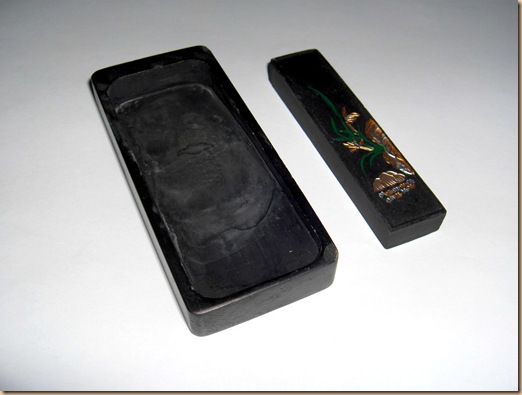On the last Cynchronicity Live webcast, I demonstrated Japanese Sumi-e Painting. Sumi-e means ink picture and was brought to Japan from China so if you’re familiar with Chinese brush painting, you will note many similarities between the two.
Materials used in Sumi-e painting:
Pictured above: Grinding stone and ink stick
The Suzuri (Ink Grinding Stone) has a flat stone, indentation and well. A small amount of water is put into the well and then you rub ink stick back and forth drawing moisture from the well to the surface of the stone. The time it takes for properly grinding the ink can take up to half an hour and this is supposed to be used as a time of contemplation and reflection. When it’s time to paint, it is best to use a white (preferably ceramic) palette. Move ink from the grinding stone to the palette and then add water to create 5-7 shades of ink. It is difficult to see the true shade of the ink on the grinding stone and the white palette allows you to see the shades more easily.
Sumi-e Inkstick
There are two kinds of ink sticks available:
Yuen-boku: which is made from lampsoot (warm in tone)
Shoen-boku: which is made from pine soot (cool in tone, slightly bluish)
Often dedicated Sumi-e artists will have both types of ink sticks available so that they can achieve both tones. In most beginning Sumi-e kits available on the market, they provide Yuen-boku.
Hake: This is a big flat goat hair brush, used mainly for applying washes as backgrounds

Bamboo: These brushes are used for the main parts of the painting and for detail
Papers: Papers used for Sumi-e painting vary in strength and smoothness but are often varieties of rice paper.
Grass paper – less absorbent, considered better for practice as it allows more control of the ink, tears more easily and thus is not as appropriate for larger or more detailed paintings
Xuan paper – high absorbency, the white colour keeps from interfering with true colours you are using
Shikishi paper – stronger more durable rice paper, nice smooth surface, good absorbency (my favourite one to use)
Felt mat: This is used under the paper for absorption as paper is very porous. A white piece of felt is best as there are no worries of the dye from the felt coming off onto your paper.
Paperweight: It can often be helpful to use a paperweight to hold paper down and prevent curling.
Methods: The traditional way of teaching Sumi-e is with the Four Gentlemen method. The Four Gentleman are Bamboo, Orchid, Chrysanthemum, and Plum. Each of these teaches four basic groups of strokes. In this webcast, I show some of the basic strokes used in painting bamboo.
Hold the brushes with thumb and forefinger, just past center, closest to bristles. There are two main positions for holding the brushes:
Choko-hitsu position – straight up and down, great for line drawing
Soku-hitsu position – slanted position, drawing with a more generous ink flow
When finished painting, it is important to clean the grinding stone and brushes well with clean cool water (no soap) after use. A build-up of ink on any of your supplies can interfere with getting good clean results next time.
To learn more of the tips and tricks for this type of painting and to see the bamboo painting techniques in action, check out the recording of Cynchronicity Live, March 21, 2012: https://www.linqto.com/PlaybackRoom.aspx?roomname=creativeedventures&name=SingleExplicit_2012_03_21_20_00_07_186




Leave a Reply